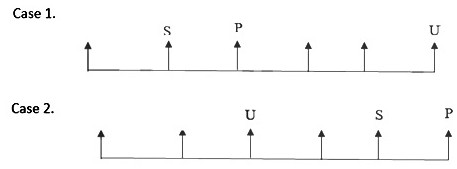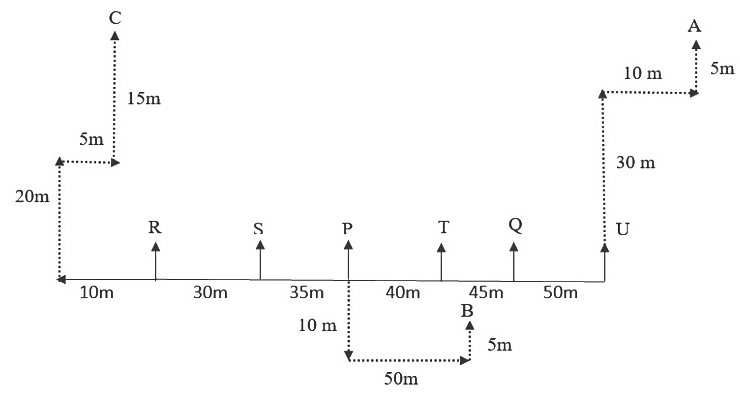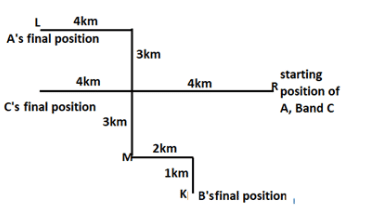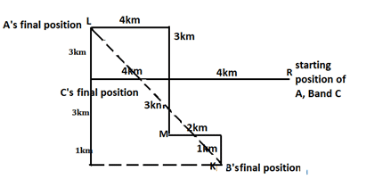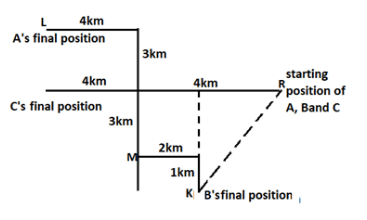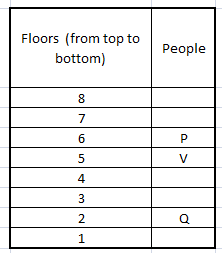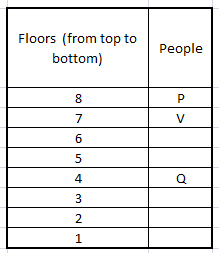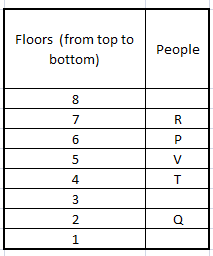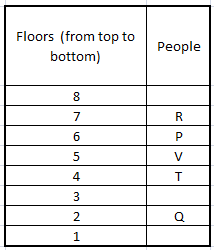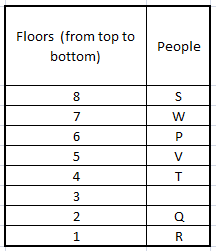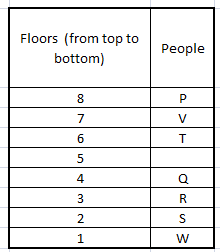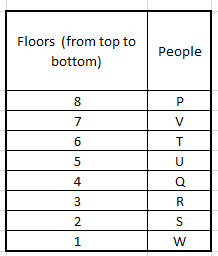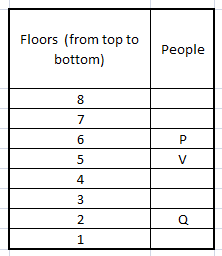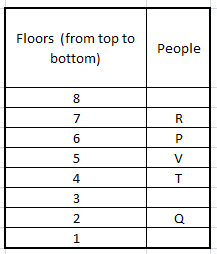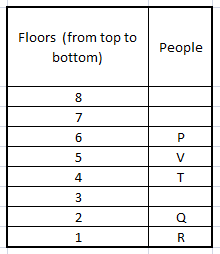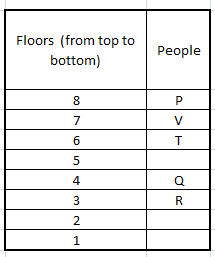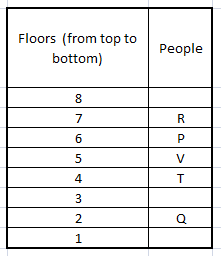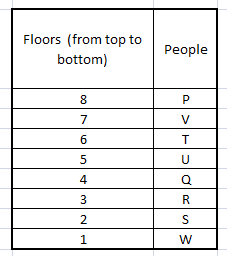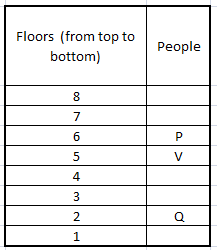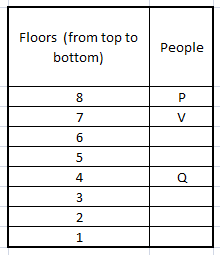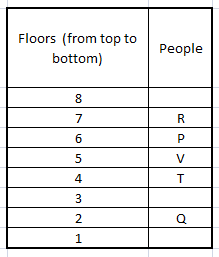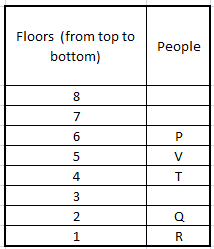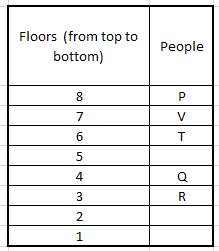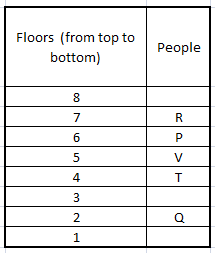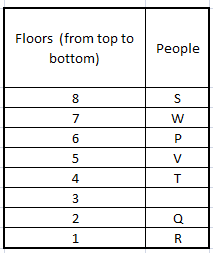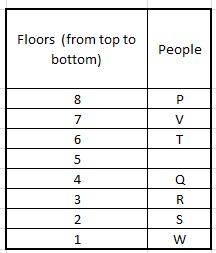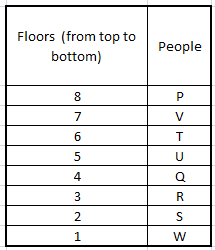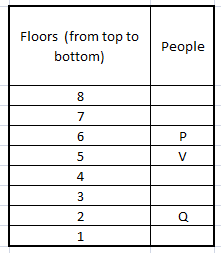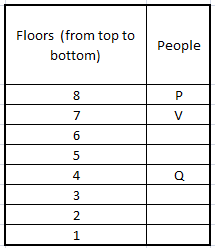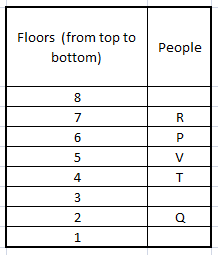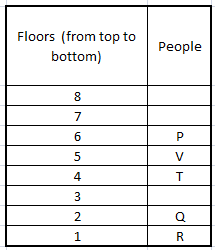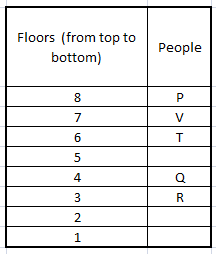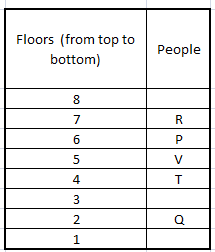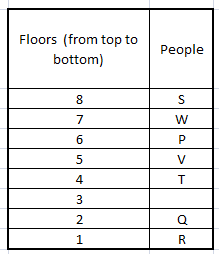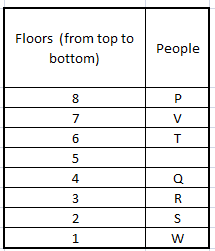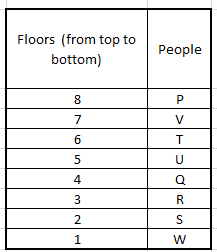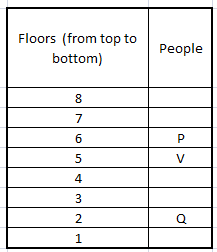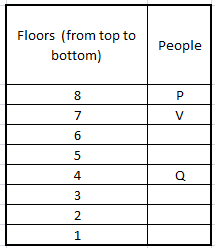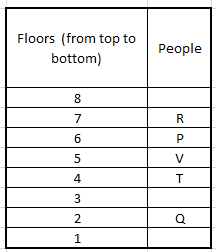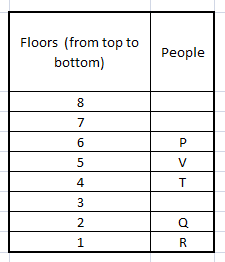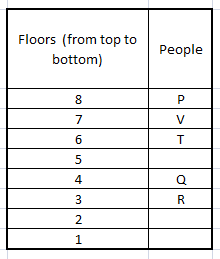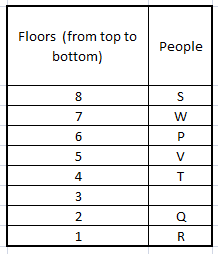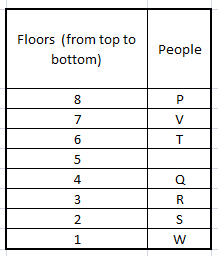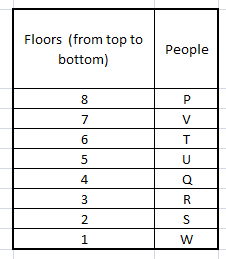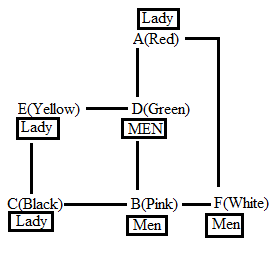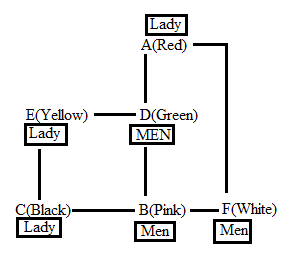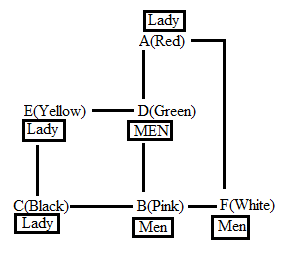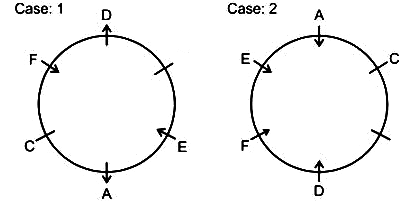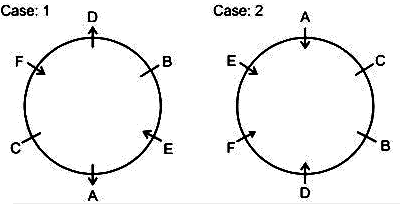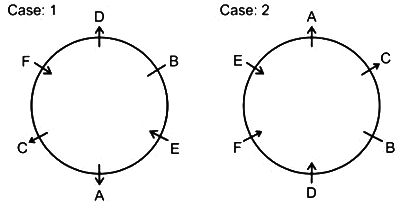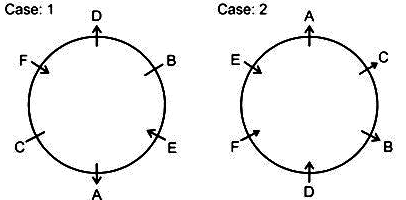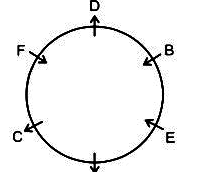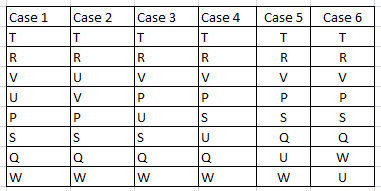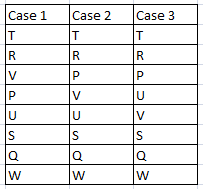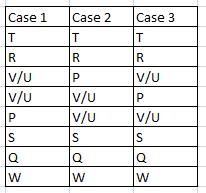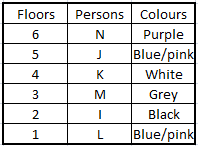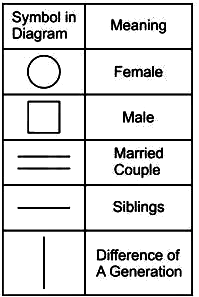IBPS RRB PO (Scale 1) Mains Mock Test - 7 - Bank Exams MCQ
30 Questions MCQ Test - IBPS RRB PO (Scale 1) Mains Mock Test - 7
Directions: Study the following information carefully and answer the questions given below.
Six buses P, Q, R, S, T and U are made to stand in a row facing north and the distance between two adjacent buses increases from left to right, in consecutive integral multiple of 5. Only two buses stand between P and U, one of them stands at the right end of the row. The distance between R and T is 105 meters. The distance between T and U is 95 meters. T stands somewhere to the left of U. S stands immediate to the left of P. Only one bus stands between S and T. Bus U starts towards North, after moving 30 meters, it turns to its right and moved 10 meters. Again it turns left and moves 5 meters it reaches at a point A. Bus P, moves in the South direction for a distance of 10 meters and then turns to its left and moves 50 meters. After taking one more turn to its left it stops at point B after moving 5 meters. Bus R, moves west and travels 10 meters before turning to its right. After moving 20 meters it takes the right turn and moves 5 meters. After taking one more turn to its left it stops at point C after moving 15 meters.
Q. What is the distance between Point A and Point C?
Read the following information carefully and answer the question given below-
A, B and C started walking in the west direction from point R such that after walking 4 km A takes a right turn and walks 3 km and takes a left turn and walks 4 km to reach point L. From the same position where A takes his first right turn, C walks straight for 4 km but B takes a left turn and walks for 3 km to reach point M and then again he takes a left turn and walks for 2 km and finally takes a right turn and walks for 1 km to reach point K.
Q. In which direction is C now with respect to C’s initial position?
Read the following information carefully and answer the question given below-
A, B and C started walking in the west direction from point R such that after walking 4 km A takes a right turn and walks 3 km and takes a left turn and walks 4 km to reach point L. From the same position where A takes his first right turn, C walks straight for 4 km but B takes a left turn and walks for 3 km to reach point M and then again he takes a left turn and walks for 2 km and finally takes a right turn and walks for 1 km to reach point K.
Q. In which direction is C’s final position with respect to A’s final position?
Read the following information carefully and answer the question given below-
A, B and C started walking in the west direction from point R such that after walking 4 km A takes a right turn and walks 3 km and takes a left turn and walks 4 km to reach point L. From the same position where A takes his first right turn, C walks straight for 4 km but B takes a left turn and walks for 3 km to reach point M and then again he takes a left turn and walks for 2 km and finally takes a right turn and walks for 1 km to reach point K.
Q. What is the shortest distance between point L and B’s final position?
Read the following information carefully and answer the question given below-
A, B and C started walking in the west direction from point R such that after walking 4 km A takes a right turn and walks 3 km and takes a left turn and walks 4 km to reach point L. From the same position where A takes his first right turn, C walks straight for 4 km but B takes a left turn and walks for 3 km to reach point M and then again he takes a left turn and walks for 2 km and finally takes a right turn and walks for 1 km to reach point K.
Q. What is the distance between starting position of C and final position of B?
Direction: Read the given information carefully and answer the question asked below.
Eight people P, Q, R, S, T, U, V and W live in an eight floor building, but not necessarily in the same order. Each floor is numbered as 1 to 8 from bottom to top respectively. P lives on an even-numbered floor but not on the floor numbered second or fourth.
Only three floors are there between P and Q. V lives immediately below P’s floor. There are equal numbers of floors between the floors on which T and Q live and between the floors on which P and T live. Only two people live between R and T. W lives immediately below S’s floor. U lives on a floor above S.
Q. Who lives immediate above U?
Direction: Read the given information carefully and answer the question asked below.
Eight people P, Q, R, S, T, U, V and W live in an eight floor building, but not necessarily in the same order. Each floor is numbered as 1 to 8 from bottom to top respectively. P lives on an even-numbered floor but not on the floor numbered second or fourth.
Only three floors are there between P and Q. V lives immediately below P’s floor. There are equal numbers of floors between the floors on which T and Q live and between the floors on which P and T live. Only two people live between R and T. W lives immediately below S’s floor. U lives on a floor above S.
Q. How many people live between S and P?
Direction: Read the given information carefully and answer the question asked below.
Eight people P, Q, R, S, T, U, V and W live in an eight floor building, but not necessarily in the same order. Each floor is numbered as 1 to 8 from bottom to top respectively. P lives on an even-numbered floor but not on the floor numbered second or fourth.
Only three floors are there between P and Q. V lives immediately below P’s floor. There are equal numbers of floors between the floors on which T and Q live and between the floors on which P and T live. Only two people live between R and T. W lives immediately below S’s floor. U lives on a floor above S.
Q. Who lives three floors below the one who lives immediate below V?
Direction: Read the given information carefully and answer the question asked below.
Eight people P, Q, R, S, T, U, V and W live in an eight floor building, but not necessarily in the same order. Each floor is numbered as 1 to 8 from bottom to top respectively. P lives on an even-numbered floor but not on the floor numbered second or fourth.
Only three floors are there between P and Q. V lives immediately below P’s floor. There are equal numbers of floors between the floors on which T and Q live and between the floors on which P and T live. Only two people live between R and T. W lives immediately below S’s floor. U lives on a floor above S.
Q. How many people live between S and P?
Direction: Read the given information carefully and answer the question asked below.
Eight people P, Q, R, S, T, U, V and W live in an eight floor building, but not necessarily in the same order. Each floor is numbered as 1 to 8 from bottom to top respectively. P lives on an even-numbered floor but not on the floor numbered second or fourth.
Only three floors are there between P and Q. V lives immediately below P’s floor. There are equal numbers of floors between the floors on which T and Q live and between the floors on which P and T live. Only two people live between R and T. W lives immediately below S’s floor. U lives on a floor above S.
Q. Four of the following five options are alike in a certain way, find out the odd one?
the given statements carefully and answer the questions that follow:
(i) There are 6 persons in a family— A, B, C, D, E and F.
(ii) These persons are of three generations and there are two couples in the family.
(iii) Each person has a different choice of colours from green, yellow, black, red, white and pink.
(iv) None of the lady likes neither green nor white colour.
(v) C is the daughter-in-law of E and likes black colour.
(vi) B is the brother of F and son of D. He likes pink colour.
(vii) A is the grandmother of F who does not like red colour.
(viii) The person who likes green colour has a wife who likes yellow colour.
Q. What is true about F?
the given statements carefully and answer the questions that follow:
(i) There are 6 persons in a family— A, B, C, D, E and F.
(ii) These persons are of three generations and there are two couples in the family.
(iii) Each person has a different choice of colours from green, yellow, black, red, white and pink.
(iv) None of the lady likes neither green nor white colour.
(v) C is the daughter-in-law of E and likes black colour.
(vi) B is the brother of F and son of D. He likes pink colour.
(vii) A is the grandmother of F who does not like red colour.
(viii) The person who likes green colour has a wife who likes yellow colour.
Q. Which colour does A like?
the given statements carefully and answer the questions that follow:
(i) There are 6 persons in a family— A, B, C, D, E and F.
(ii) These persons are of three generations and there are two couples in the family.
(iii) Each person has a different choice of colours from green, yellow, black, red, white and pink.
(iv) None of the lady likes neither green nor white colour.
(v) C is the daughter-in-law of E and likes black colour.
(vi) B is the brother of F and son of D. He likes pink colour.
(vii) A is the grandmother of F who does not like red colour.
(viii) The person who likes green colour has a wife who likes yellow colour.
Q. How many gents are there in the family?
the given statements carefully and answer the questions that follow:
(i) There are 6 persons in a family— A, B, C, D, E and F.
(ii) These persons are of three generations and there are two couples in the family.
(iii) Each person has a different choice of colours from green, yellow, black, red, white and pink.
(iv) None of the lady likes neither green nor white colour.
(v) C is the daughter-in-law of E and likes black colour.
(vi) B is the brother of F and son of D. He likes pink colour.
(vii) A is the grandmother of F who does not like red colour.
(viii) The person who likes green colour has a wife who likes yellow colour.
Q. Which of the following is a couple?
the given statements carefully and answer the questions that follow:
(i) There are 6 persons in a family— A, B, C, D, E and F.
(ii) These persons are of three generations and there are two couples in the family.
(iii) Each person has a different choice of colours from green, yellow, black, red, white and pink.
(iv) None of the lady likes neither green nor white colour.
(v) C is the daughter-in-law of E and likes black colour.
(vi) B is the brother of F and son of D. He likes pink colour.
(vii) A is the grandmother of F who does not like red colour.
(viii) The person who likes green colour has a wife who likes yellow colour.
Q. Which of the following is the choice of any one of the two couples?
Direction: The question below consists of a question and three statements numbered I, II and III given below it. You have to decide whether the data provided in the statements are sufficient to answer the question.
There are seven members in a family A, B, C, D, E, F and G. C is married to F and is grandmother of B. C does not have more than two children. D is the son of F and is not married to A. How is B related to G?
Statement I: E is the paternal uncle of B. A is a female member of the family.
Statement II: A is the wife of E, who is paternal uncle of B.
Statement III: B is the niece of A. G is not married to E.
Direction: In the question below are given two statements followed by two Conclusions 1 and 2. You have to consider the statements to be true, even if they seem to be at variance from commonly known facts. You are to decide which of the following conclusions can definitely be drawn from the given statements and indicate your answer accordingly.
Statements:
I: The fundamental reason for having a refrigerator is to keep the food cold and thus retaining its freshness.
II: The basic idea behind refrigeration is to slow down the activity of the bacteria present in food.
Conclusions:
1: Cold temperatures help the food to stay fresh.
2: Bacteria will take a longer time to spoil the food on refrigeration.
Direction: The question below consists of a question and three statements numbered I, II and III given below it. You have to decide whether the data provided in the statements are sufficient to answer the question.
Six persons A, B, C, D, E and F sitting around a circular table, some facing inside and some facing outside. D sits third to the right of A, who is an immediate neighbour of E. C sits second to the left of E who is facing inside. F faces inside and sits at the immediate left of D. Who is sitting second to the right of B?
Statement I: B is an immediate neighbour of D and he is sitting to the second left of A.
Statement II: E sits second to the left of C, who is on the immediate right of A.
Statement III: Three person faces inside the circle. A is not facing inside the circle.
Direction: The question below consists of a question and three statements numbered I, II and III given below it. You have to decide whether the data provided in the statements are sufficient to answer the question.
Eight persons P, Q, R, S, T, U, V and W have different heights. No two persons have the same height. P is shorter than R and T but taller than Q and Q is not the shortest person. R is taller than U and V but not the tallest of all. S is shorter than P but taller than Q and W. How many persons are shorter than P?
Statement I: V is taller than P but shorter than T.
Statement II: P is taller than U who is taller than S and V is not shorter than S.
Statement III: U and V are taller than S.
19 persons are standing in a queue. Manish is 7th from the back. Rinku is exactly in the middle of Manish and Seema. Seema and Rinku have three persons between them.
What is the position of Seema from the front?
Each of the question below consists of one question and some statements given below it. Read all the statements carefully and find out which of the statement is/are sufficient to answer the given question.
In the given question, one question is given followed by data in three statements I, II and III. You have to study the question and the data in statements and decide the question can be answered with data in which of the statements and mark your answer accordingly.
Six people viz. I, J, K, L, M and N live in a building on different floors from top to bottom (such as the ground floor numbered as 1, and the top is numbered as 6). Each likes different colours Black, White, Blue, Pink, Purple, Grey.
Which, colour is liked by the one who lives on 4th, floor ?
I. Only one person lives between L and M. J lives at one of the floor above I who likes Black colour.
II. K likes White colour. The one who likes Grey colour lives above I. J does not like Grey colour.
III. There is a gap of three floors between J and L and both of them lives on odd number of floor. The one who lives on top floor likes Purple colour.
In the following question, one question is given, followed by data in two statements I and II. You have to study the question and the data in the statements and decide the question can be answered with which of the statements and mark your answer accordingly.
Mohit is taller than Ashok, Gopal is taller than Prabodh. Who is the tallest?
To answer this question which of the following two information given below is necessary?
(1) Ashok is taller than Gopal.
(2) Gopal is shorter than Ashok.
In the question given two statements (I) and (II). These statements may be either independent causes or may be effects of independent causes or a common cause. One of these statements may be the effect of the other statement. Read both the statements and decide which of the following answer choice correctly depicts the relationship between these two statements. Mark: (A) If statement I is the cause and statement II is its effect. (B) If statement II is the cause and statement I is its effect. (C) If both the statements I and II are independent causes. (D) If both the statements I and II are effects of independent causes. (E) If both the statements I and II are effects of some common causes.
Cause: The Government has recently increased its taxes on Petrol and diesel by about 10%
Which of the following can be a possible effect of the above cause?
In the following question, one question is given followed by data in two statements I and II. You have to study the question and the data in the statements and decide the question can be answered with which of the statements and mark your answer accordingly.
Who is wearing a red shirt among Pravir, Subodh, Gopal, and Suresh?
(1) Each one of them is wearing a different coloured shirt.
(2) Pravir and Gopal are wearing yellow and blue shirts respectively and Subodh is wearing a green shirt.
A + B means ‘A is the sister of B’;
A - B means ‘A is the father of B’;
A × B means ‘A is the son of B’;
A ÷ B means ‘A is the Wife of B’
If, E ÷ F - H + J ÷ G × D, then how is E related to G?
There are five friends P, Q, R, S and T. S is shorter than T but taller than P. R is the tallest. Q is a little shorter than T but little taller than S. If they stand in the order of their heights who will be the shortest?
Direction: Read the instructions carefully and answer the question below.
Right before Holi, a trader imported environmental friendly colours from other states. He got nine boxes that contain nine different colours, Orange, Pink, Blue, Red, Black, Green, Yellow, Purple, and Brown. These nine boxes are stacked upon one another in the go-down but not necessarily in the same order.
Four boxes are kept between the boxes that contain Pink and Orange colour. Three boxes are kept between the boxes that contain Green and Red colour and either of them is at the top. The box that contains Orange colour is kept immediately below the box that contains Green colour. The box that contains Yellow colour is kept immediately below the box that contains Blue colour. Only one box is kept between the boxes that contain Brown and Yellow colour. The box that contains Black colour is not kept at the bottom.
Q. Which box is placed immediately above the Pink box?
Direction: Read the instructions carefully and answer the question below.
Right before Holi, a trader imported environmental friendly colours from other states. He got nine boxes that contain nine different colours, Orange, Pink, Blue, Red, Black, Green, Yellow, Purple, and Brown. These nine boxes are stacked upon one another in the go-down but not necessarily in the same order.
Four boxes are kept between the boxes that contain Pink and Orange colour. Three boxes are kept between the boxes that contain Green and Red colour and either of them is at the top. The box that contains Orange colour is kept immediately below the box that contains Green colour. The box that contains Yellow colour is kept immediately below the box that contains Blue colour. Only one box is kept between the boxes that contain Brown and Yellow colour. The box that contains Black colour is not kept at the bottom.
Q. Which box is placed at the 4th position from the top?
Direction: Read the instructions carefully and answer the question below.
Right before Holi, a trader imported environmental friendly colours from other states. He got nine boxes that contain nine different colours, Orange, Pink, Blue, Red, Black, Green, Yellow, Purple, and Brown. These nine boxes are stacked upon one another in the go-down but not necessarily in the same order.
Four boxes are kept between the boxes that contain Pink and Orange colour. Three boxes are kept between the boxes that contain Green and Red colour and either of them is at the top. The box that contains Orange colour is kept immediately below the box that contains Green colour. The box that contains Yellow colour is kept immediately below the box that contains Blue colour. Only one box is kept between the boxes that contain Brown and Yellow colour. The box that contains Black colour is not kept at the bottom.
Q. The box of which color is placed at the bottom?
Direction: Read the instructions carefully and answer the question below.
Right before Holi, a trader imported environmental friendly colours from other states. He got nine boxes that contain nine different colours, Orange, Pink, Blue, Red, Black, Green, Yellow, Purple, and Brown. These nine boxes are stacked upon one another in the go-down but not necessarily in the same order.
Four boxes are kept between the boxes that contain Pink and Orange colour. Three boxes are kept between the boxes that contain Green and Red colour and either of them is at the top. The box that contains Orange colour is kept immediately below the box that contains Green colour. The box that contains Yellow colour is kept immediately below the box that contains Blue colour. Only one box is kept between the boxes that contain Brown and Yellow colour. The box that contains Black colour is not kept at the bottom.
Q. Which of the following is correct about the position of the box that contains Blue colour?


